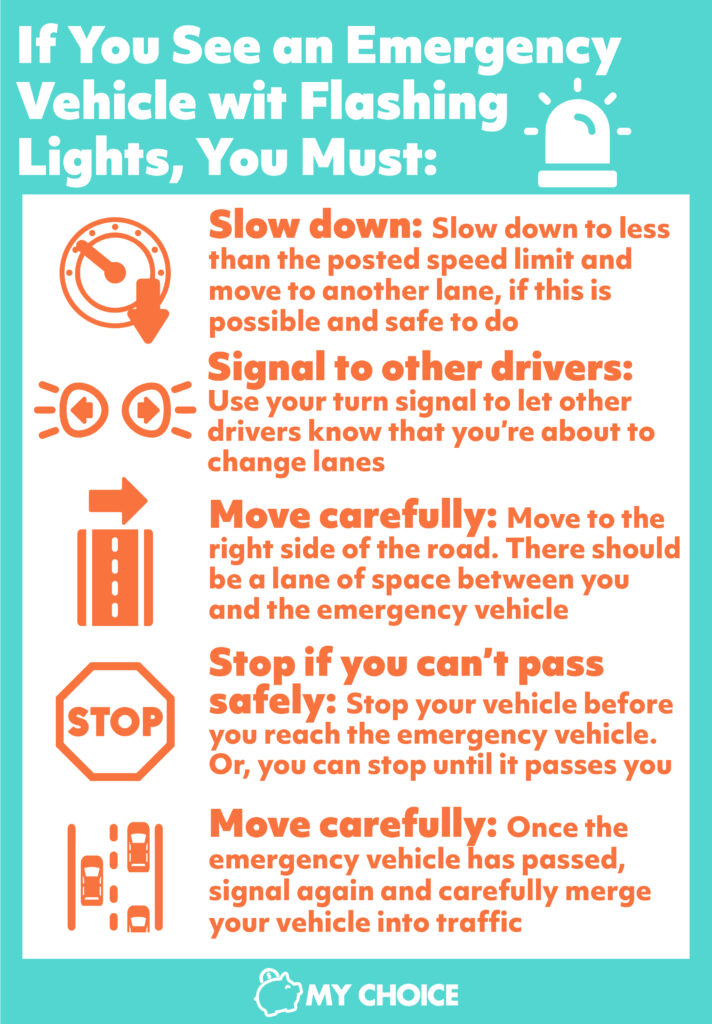
While driving on any of Canada’s highways, you may have noticed cars giving way to emergency vehicles so they can reach an accident site. However, you may also have noticed that some drivers don’t slow down and move over, causing them to get ticketed.
Despite having been in force for over a decade, many Ontario drivers are unaware of or fail to observe Ontario’s Move Over law.
But what is the Move Over law? How many demerit points for failing to move where possible, and how do you properly move over for emergency vehicles? In this guide, we explain how this law works in Ontario and other Canadian provinces, as well as how to comply safely.
What Is the Move Over Law in Ontario?
Also known as Section 159 (2,3) of Canada’s Highway Traffic Act, the Move Over law in Ontario states that drivers are required to slow down and move over to another lane when they approach emergency vehicles with flashing lights. Emergency vehicles under this law include tow trucks, fire trucks, police cars, public utility vehicles, and ambulances.
This law is important because it protects first responders and emergency workers on the side of the road. It applies to every driver on a road with a speed limit of 80 km/h or less.
If you see an emergency vehicle with flashing lights, you must do the following:
- Slow down: Slow down to less than the posted speed limit and move to another lane, if this is possible and safe to do.
- Signal to other drivers: Use your turn signal to let other drivers on the road know that you’re about to change lanes.
- Move carefully: Move to the right side of the road, making sure that you’re clear of any intersections. There should be a lane of space between your vehicle and the emergency vehicle.
- Stop if you can’t pass safely: If you can’t safely move over to another lane, stop your vehicle before you reach the emergency vehicle. Alternatively, you can stop until the emergency vehicle passes your vehicle.
- Get back on the road: Check to make sure the emergency vehicle has passed. Once it has and the road is clear, signal again and carefully merge your vehicle into traffic.

Move Over Law Ontario Penalties
The penalties for violating the Move Over law in Ontario will depend on whether it’s your first offence or if you’ve violated the law repeatedly. The penalties are as follows:
First offence:
- A ticket fine ranging from $400 to $2,000
- Three demerit points on your Ontario driving record
- Possible suspension of your driver’s licence for up to two years
For any succeeding offences committed within five years:
- Three demerit points on your Ontario driving record
- Fines ranging from $1,000 to $4,000
- Possible imprisonment for up to six months
- Possible suspension of your driver’s licence for up to two years
Check your driving record to see how many incidents you’ve had in the past years and how they may affect your insurance rates. Note that your Ontario driving record resets every two years, but car insurance companies may look at your driving history up to ten years ago.
Emergency Vehicles on Highway Rules by Province
Every Canadian province has a different version of a Move Over law to protect emergency vehicles. To avoid getting demerits and affecting your driving record, always check the traffic laws of the place where you’re driving.
Here are different Move Over laws in other parts of Canada:
- Alberta: Drivers are required to slow down to a speed of 60 km/h or less, if the speed limit is lower in the area you’re passing. Drivers must also move over to a lane if this is safe and possible.
- British Columbia: When approaching an emergency vehicle, drivers have to slow down to 70 km/h if they’re in an area with a speed limit of 80 km/h. If they’re driving along a road with a lower limit, they’re required to drop to a speed of 40 km/h.
- Manitoba: Drivers need to slow down to 40 km/h or slower if the area where the emergency vehicle is located has a speed limit of more than 40 km/h but less than 79 km/h. If the speed limit in the area is 80 km/h, drivers should slow down to 60 km/h.
- Newfoundland and Labrador: Drivers approaching an emergency vehicle travelling in the same direction must slow down to 30 km/h below the speed limit of that area. They must then stop if possible or move to another lane if there’s one available.
- New Brunswick: Drivers must slow down to half the speed limit of the area, then move to another lane if it’s safe to do so.
- Northwest Territories: There is no suggested speed limit in the Northwest Territories when passing emergency vehicles. However, drivers are still required to slow down and leave space between their vehicle and the emergency vehicle. They are also required to change lanes or stop their vehicle if necessary.
- Nova Scotia: Drivers must slow down to 60 km/h or follow the speed limit if it’s lower than 60 km/h in the area. Drivers on roads with two or more lanes should move over safely and pass the emergency vehicle, if possible.
- Nunavut: Nunavut doesn’t have posted speed limits, but drivers are still advised to give space and make way for emergency vehicles. Drivers should pull over to the right as much as they can, if this is safe and possible. They should also be prepared to stop if necessary, but should not block intersections.
- PEI: Drivers who see emergency vehicles are required to slow down to half the area’s speed limit and move over to another lane if it’s safe to do so.
- Quebec: Quebec doesn’t have strict limits on driver speeds, but drivers are still advised to drop their driving speed to safe and reasonable limits. Drivers should also change lanes if possible.
- Saskatchewan: Drivers are required to drop their speed to at least 60 km/h to give way to all emergency vehicles.
- Yukon: Yukon doesn’t have a Move Over law, but there’s a strong, continuing advocacy for slowing down and giving way for emergency vehicles. Drivers’ handbooks continually highlight that emergency vehicles have right of way in Yukon, so it’s still best to slow down and change lanes if possible.
How to Move Over Safely on Different Types of Roads
Depending on the type of road you’re driving on, there are different ways you can safely give way to emergency vehicles. Here are some tips for how to do so on different road types in Ontario:
- On multi-lane highways
- Slow down, signal, then carefully turn to the right.
- Move over to the rightmost lane if possible, as this will make it easier for other drivers to see you. Don’t move to the shoulder.
- If you can’t move, stay in your lane and drive carefully and slowly.
- At an intersection
- If the emergency vehicle is approaching behind your vehicle, proceed through the intersection, pull to the right side, and stop.
- Don’t block the intersection.
- On a one-way road
- Signal, then pull to the left side of the road if possible, and stop.
- On a two-way road
- Signal, then pull your vehicle as close to the right edge of the road.
- Make sure your vehicle is clear of any intersections, then stop.
How to React When Emergency Vehicles Are Present
Here are tips for reacting responsibly in the presence of an emergency vehicle:
- Act with caution: Approach emergency vehicles carefully and leave them plenty of space on the road. Once they’ve passed your vehicle, double-check to make sure the way is clear before merging into traffic.
- Be alert: Keep your eyes on the road and avoid getting distracted while driving. Check all your car mirrors, and check on your vehicle’s front and sides.
- Use signals: Use your signal when you’re planning to change lanes to move over for an emergency vehicle.
- Stay on the road: Don’t drive on the shoulder or block the shoulder on freeways.
- Remain calm: Focus on driving safely and giving enough space to both fellow drivers and the emergency vehicle.
- If you’re in heavy traffic, stop: Don’t try to move over. Just stay in your lane and wait for the emergency vehicle to pass by.
- Avoid sudden movements: Don’t make sudden lane changes or hit the brakes. Before changing your driving direction and speed, check road conditions and any blind spots you may have while driving to avoid accidents.
- Do not follow the emergency vehicle: It’s against the law to follow a fire truck or ambulance responding to a call within 150 metres.
Frequently Asked Questions About the Move Over Law in Ontario
Does the Move Over law affect my Ontario car insurance?
Yes, it does. If you’ve been penalized for violating the Ontario Move Over law, this results in tickets, fines, and demerit points.
All of these go on your Ontario driving record, which your insurer looks at to assess the risk of insuring you. The more violations and demerits on your record, the likelier you are to be considered a high-risk driver – and the higher your car insurance rates.
Do I have to follow the Move Over law when I’m driving on a roundabout?
No, you don’t have to follow the Move Over law when you’re driving on a roundabout. However, you’ll need to yield to traffic on your right side and proceed with caution while entering and exiting the roundabout.
How do I fight a ticket for violating the Move Over law?
If you’ve been pulled over and issued a ticket for violating the Move Over law, there are a few things you can do to successfully fight it and avoid fines and demerits.
Start by finding a lawyer who specializes in traffic violations and consult them about your situation. They’ll be able to advise you if you have a strong chance of successfully fighting the ticket, as well as other courses of action you should take.
The second thing you should do is gather as much evidence as you can. The more evidence you have to support your case, the stronger your chances of avoiding a fine and demerits. Get a copy of the police report from the officer who issued your ticket, as well as eyewitness testimonies from your passengers or other drivers who may have seen what happened.
Are tow trucks considered emergency vehicles under the Move Over law?
Yes, tow trucks are considered emergency vehicles under the Move Over law since 2015. If you see a tow truck with flashing amber lights on the side of the road, the Move Over law requires you to slow down and proceed with caution in Ontario. Failing to do so with a tow truck will subject you to demerit points and a fine.
The Bottom Line
The Move Over law in Ontario allows emergency vehicles to reach areas quickly and safely. Failing to observe it can seriously affect the speed and efficiency of emergency responders, which is why violating this law is penalized with fines and demerit points.
Make it a habit to slow your vehicle down if there’s an emergency vehicle approaching you. Get out of the way if it’s safe to do so, or stop if you can’t move your car. By slowing down and driving with caution, you help emergency responders move swiftly and avoid getting into potential accidents with fellow drivers.








